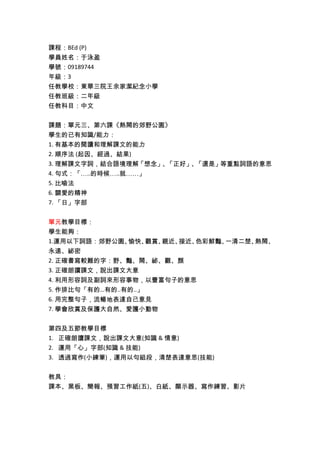22 03-2012教案[itce]
- 2. 日期:22-03-2012
教學步驟:
時間 教學流程 教學活動 評估 教具
及策略
第四 & 五 1. 引起回 提問:大家喜歡小動物嗎? 課本、簡報
教節 憶 喜歡什麼小動物?用 1 分
5 分鐘 鐘與同組同學分享(外貌、 本
領、喜歡的原因)
請同學分享
引入課文:每人都喜歡不同
的小動物,不知道課文中
的小動物你又喜不喜歡呢?
不如我們先一起看看課文
吧!
40 分鐘 2. 引導學 提問:朗讀課文時要注意 1. 朗讀能表現 課本、簡報、影片
生理解課 什麼地方? 文章的語感
文各段落 (感情、語速、讀音)
的大意 2. 清楚說出問
請同學朗讀第一段 題的答案
(能說出段落大
提問(複述):我一到郊野公 意)
園,心情怎樣?為什麼?
(一到郊野公園,我就感到 3. 與同儕良好
心情愉快,因為可以觀賞 合作
到許多有趣的小動物。)
請同學朗讀答案,從而加
強對文章的理解
提問(延伸):你們去郊野公
園時除了愉快還有什麼感
受?(聯繫個人經驗)
- 3. 請同學朗讀第二段
提問(複述):公園裏可愛的
小動物身在哪裏?
(可愛的小動物,有的藏在
土裏,
有的停在樹上,有的躲在
水中,
有的在空中飛呀飛呀。)
請同學朗讀答案,從而加
強對文章的理解
提問(延伸):有什麼動物是
藏在土裏?有什麼動物是
停在樹上?有什麼動物是
躲在水中?
請同學朗讀第三段
提問(複述):我用了什麼方
法來親近這些可愛的小動
物?
(為了親近小動物,我會穿
着接近大自然顏色的衣服,
輕輕地走、仔細地看。)
請同學朗讀答案,從而加
強對文章的理解
提問(延伸):問問同學認為
哪些是接近大自然的顏色?
為什麼?
(自由作答,如綠色、啡色。)
提問(延伸):想一想,作者
為什麼要輕輕地走、仔細地
看?
- 4. 小組討論(1 分鐘)
(因為這樣便不會嚇跑小動物,
也能把牠們看得清楚。)
提問(複述):結果,我發現
到什麼動物?
(在樹林裏,我聽到小鳥悅
耳的歌聲;在花叢裏,美
麗的蝴蝶、色彩鮮豔的甲蟲,
還有那背着硬殼的蝸牛,
我都看得一清二楚。)
請同學朗讀答案,從而加
強對文章的理解
請同學朗讀第四段
提問(複述):我在郊野公園
裏有什麼感想?
(輕輕地走、仔細地看,每次
我都有新的發現。在熱鬧的
郊野公園裏,永遠有看不
完的祕密。)
請同學朗讀答案,從而加
強對文章的理解
提問(延伸):想一想,為什
麼在熱鬧的郊野公園裏,
永遠有看不完的祕密呢?
小組討論(1 分鐘)
(自由作答,如:因為郊野公園
裏有很多小動物,牠們有不同
的外表、動作……)(例:螞蟻,
細小身軀)
提問(延伸 & 創意):猜猜看,
「我」又發現了什麼祕密呢?
小組討論(1 分鐘)
- 5. (自由作答)
提問(情意延伸):當我們在
公園發現一些小動物時,
例如蝸牛,雖然看著會覺
得噁心(老師自己角度),但
老師不會特地去打擾牠們,
你們覺得老師這樣做的原
因是什麼?
(自由作答)
提問(簡單):打、殺或騷擾
小動物這些行為應不應該?
我們應該如何對待小動物?
3 分鐘 3. 小結 提問:你也喜歡到郊野公
園遊玩嗎?為什麼?
(自由作答)
提問:除了郊野公園,你
還去過哪些與大自然有關
的地方遊玩?與同學分享
一下經歷。
(自由作答)
12 分鐘 4. 學習 過渡:我們完整地把課文 1. 正確運用心 預工(五)、課本、簡
「心」 字部 看了一遍,不知同學有沒 字部 報、顯示器
有發現文中有很多有「心」
字或「忄」作偏旁的字
利用「心」字部的字引起學
生注意:有不同面貌
解釋「心」部的運用:「心」
字的來源及演變(簡介)
課文練習 (p.43)
- 6. 請學生從書中找出所有有
「心」部的字(預工(五))
15 分鐘 5.寫作(小 透過這篇課文,我們知道 寫作以段落 寫作練習、簡報
練筆) 了要愛護小動物,現在請 形式
你們回家做一個小練筆。題 文句通順
目是《我喜愛的動物》
我們一起看看有什麼動物。
提問 1:你們最喜愛的動物
是什麼呢?
認識參考詞語
請同學把參考詞句讀一遍,
1. 文章裏要告訴老師你最
喜愛的動物是什麼,寫一
種動物好了
2. 這種動物的外貌是怎樣
的?例如牠的身體是什麼
顏色的?然後可以形容一
下牠的頭、耳朵、眼睛是怎
樣的?
3. 牠的本領是什麼?
4. 喜歡牠的原因?
例如(簡報):老師最喜歡白
色的兔子。牠們最可愛的地
方是頭上有一對長長的耳
朵。牠們的眼睛圓溜溜的,
像兩顆耀眼的黑珍珠。我喜
歡兔子,因為牠們很溫馴
和善良,因此我要好好保
護牠們。
請同學朗讀一次
- 7. 請同學回家與家人一起做
不設字數限制
請學生用心做
5 分鐘 6. 總結 1. 朗讀課文時要注意感情、語
及鞏 速、讀音,某些詞語如慢慢
固 地,朗讀時要注意語調緩慢、
輕聲
2. 從課文感悟要愛護小動物、
欣賞大自然
3. 「心」字部的運用
4. 注意寫作時要以句子組成段
落,留意句子是否通順
5.
